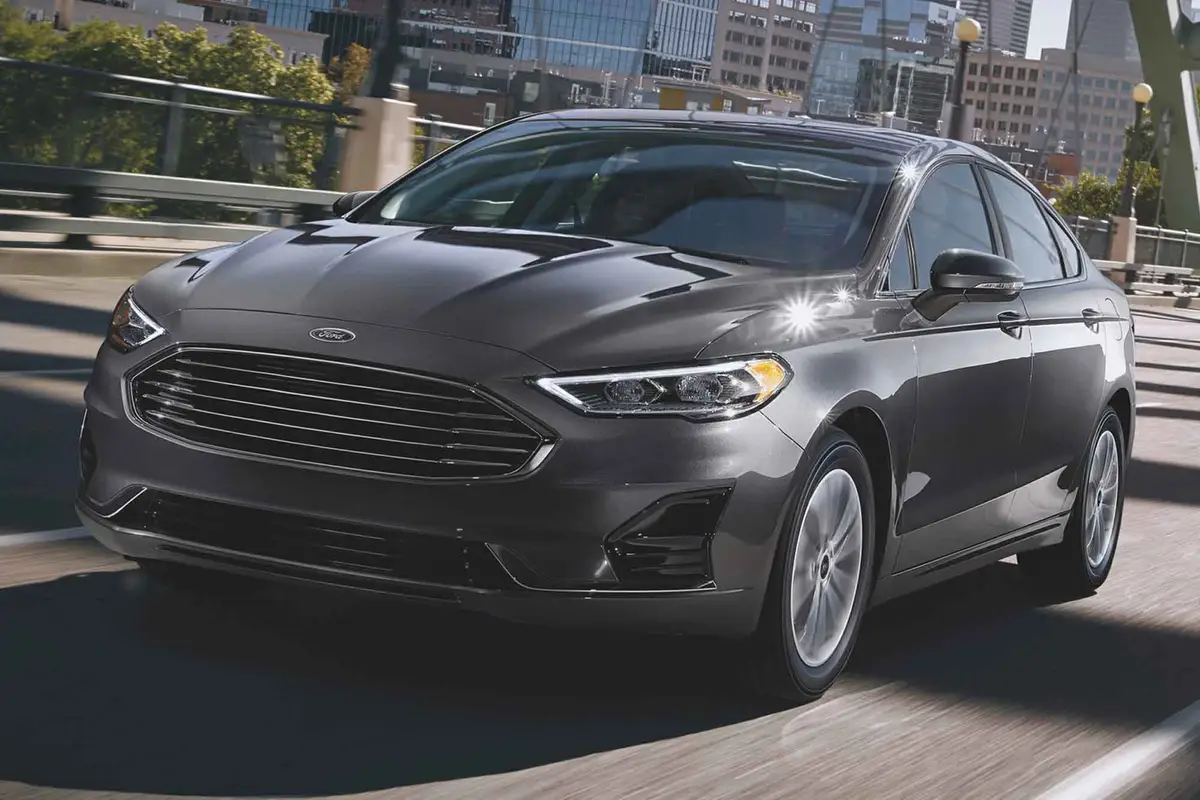Ford Escape
This content was created using generative artificial intelligence powered only by Cars.com articles and edited by Cars.com’s Editorial team for accuracy.
The Ford Escape compact SUV joined the Ford lineup — alongside the bigger Explorer, Expedition and now-defunct Excursion — in 2001, as the 1990s SUV craze spilled into the new millennium. Unlike its larger siblings, the Escape has always been a car-based SUV. Technology, comfort, safety and fuel economy have been top priorities in the five-seat Escape, with its efficient three- and four-cylinder engines, optional all-wheel drive and advanced standard safety features like automatic emergency braking and lane keeping assist.
2020-2025 Escape
Lower, wider and longer than its predecessor, the redesigned 2020 Escape got a smoother, more carlike exterior look. A 181-horsepower, turbocharged 1.5-liter three-cylinder became the standard engine, paired with an eight-speed automatic transmission. A 250-hp,

2025












































































































































































- MSRP range
- $29,515–$38,110
- Consumer rating
-
(2 reviews) - Combined mpg
- 28–39
- Body style
- SUV
- Compact five-seat SUV
- Turbocharged three-cylinder engine
- Optional turbocharged four-cylinder
- FWD or AWD
- Available hybrid and plug-in hybrid versions
2024


















































































































































































































































































- MSRP range
- $28,000–$39,610
- Consumer rating
-
(7 reviews) - Combined mpg
- 28–39
- Body style
- SUV
- Compact five-seat SUV
- Turbocharged three-cylinder engine
- Turbocharged four-cylinder optional
- Front- or all-wheel drive
- Available hybrid and plug-in hybrid versions
2023




























































































































































































































- MSRP range
- $28,000–$39,460
- Consumer rating
-
(10 reviews) - Combined mpg
- 28–39
- Body style
- SUV
- Revised styling for 2023
- Five-seat compact SUV
- Available in gas-only, hybrid and plug-in hybrid form
- Front- or all-wheel drive
- New ST-Line versions
2022












































































































































































































































































































































































































































- MSRP range
- $27,185–$37,305
- Consumer rating
-
(24 reviews) - Combined mpg
- 26–41
- Body style
- SUV
- Five-seat compact SUV
- Gas-only, hybrid and plug-in hybrid versions
- Front- or all-wheel drive
- Automatic emergency braking standard
- Apple CarPlay, Android Auto available
2021












































































































































































































































































































































































































































- MSRP range
- $25,555–$36,455
- Consumer rating
-
(22 reviews) - Combined mpg
- 26–41
- Body style
- SUV
2020


















































































































































































































































































































































































- MSRP range
- $24,885–$36,835
- Consumer rating
-
(249 reviews) - Combined mpg
- 26–41
- Body style
- SUV
2013-2019 Escape
After nearly 12 years and strong sales, Ford completely redesigned the Escape for the 2013 model year. The new “progressive” appearance retained some hallmarks from the previous generation. The V-6 engine and hybrid model disappeared, and buyers were given a choice of three four-cylinder engines

2019
































































































































































































































































- MSRP range
- $24,105–$34,120
- Consumer rating
-
(274 reviews) - Combined mpg
- 23–26
- Body style
- SUV
- Five-seat compact SUV
- Sync 3 multimedia system available
- Choice of three gas engines
- Six-speed automatic standard
- Front- or four-wheel drive
2018


































































































































































































































































- MSRP range
- $23,940–$33,490
- Consumer rating
-
(710 reviews) - Combined mpg
- 23–26
- Body style
- SUV
- New uplevel SEL trim level
- Sync 3 available
- Choice of three engines
- Six-speed automatic standard
- Front- or all-wheel drive
2017




































































































































- MSRP range
- $23,750–$31,000
- Consumer rating
-
(783 reviews) - Combined mpg
- 24–26
- Body style
- SUV
- Restyled for 2017
- Sync 3 available
- New Sport Appearance Package
- Choice of three engines
- Six-speed automatic standard
- Front- or all-wheel drive
2016








































































































































- MSRP range
- $23,590–$31,745
- Consumer rating
-
(273 reviews) - Combined mpg
- 25–26
- Body style
- SUV
- Sync 3 multimedia system newly available
- Backup camera standard
- Choice of three engines
- Six-speed automatic standard
- Front- or all-wheel drive
2015










































































































































- MSRP range
- $23,450–$31,485
- Consumer rating
-
(303 reviews) - Combined mpg
- 25–26
- Body style
- SUV
- Backup camera standard
- Seats five
- Choice of three engines
- Six-speed automatic standard
- Front- or all-wheel drive
2014


































































































































































- MSRP range
- $23,100–$30,850
- Consumer rating
-
(477 reviews) - Combined mpg
- 25–26
- Body style
- SUV
- Newly standard backup camera
- Seats five
- Choice of three engines
- Six-speed automatic
- Front- or all-wheel drive
2013
























































































































































































- MSRP range
- $22,470–$32,120
- Consumer rating
-
(479 reviews) - Combined mpg
- 24–26
- Body style
- SUV
- Escape's first full redesign
- Seats five
- Choice of three engines
- Six-speed automatic
- Front- or all-wheel drive
- Progressive styling
2001-2012 Escape
The first generation of the Ford Escape came standard with front-wheel drive and a 2.0-liter four-cylinder engine paired with a five-speed manual transmission. Higher trim levels had a 200-hp, 3.0-liter V-6 with a four-speed automatic. Mirroring its bigger siblings, the Escape had an

2012












































































































































































































- MSRP range
- $21,440–$28,120
- Consumer rating
-
(187 reviews) - Combined mpg
- 23
- Body style
- SUV
- Self-parking option
- Four-cylinder or V-6
- Available manual transmission
- Front- or all-wheel drive
- Hybrid version available
2011












































































































































































































- MSRP range
- $21,240–$27,920
- Consumer rating
-
(157 reviews) - Combined mpg
- 22–23
- Body style
- SUV
- Self-parking option
- Four-cylinder or V-6
- Available manual transmission
- Front- or all-wheel drive
- Hybrid version available
2010












































































































































































































- MSRP range
- $21,020–$27,375
- Consumer rating
-
(143 reviews) - Combined mpg
- 22–23
- Body style
- SUV
- New self-parking option
- Four-cylinder or V-6
- Five-speed manual or six-speed automatic
- Front- or all-wheel drive
- Hybrid version available
2009












































































































































































































- MSRP range
- $20,435–$27,670
- Consumer rating
-
(79 reviews) - Combined mpg
- 20–24
- Body style
- SUV
- Four-cylinder or V-6
- Five-speed manual or six-speed automatic
- Front- or all-wheel drive
- Improved gas mileage
- Hybrid version
2008






























































































































- MSRP range
- $19,140–$26,185
- Consumer rating
-
(164 reviews) - Combined mpg
- –
- Body style
- SUV
- Restyled for 2008
- 4-cylinder or V-6
- Five-speed manual or four-speed auto
- Front- or all-wheel drive
- Curtain airbags and stability system
- Hybrid version
2007
























































































































- MSRP range
- $19,320–$26,380
- Consumer rating
-
(63 reviews) - Combined mpg
- –
- Body style
- SUV
- 153-hp four-cylinder
- Available 200-hp V-6
- Available Intelligent automatic 4WD
- Optional Safety Canopy rollover protection
- Hybrid powertrain available
2006
















































































































































































- MSRP range
- $19,380–$26,680
- Consumer rating
-
(76 reviews) - Combined mpg
- –
- Body style
- SUV
- 153-hp four-cylinder
- Available 200-hp V-6
- Available Intelligent automatic 4WD
- Optional Safety Canopy rollover protection
- Hybrid powertrain available
2005






















































































































- MSRP range
- $19,425–$26,630
- Consumer rating
-
(102 reviews) - Combined mpg
- –
- Body style
- SUV
- More powerful four-cylinder
- Available V-6
- Availability of new "
- Intelligent"
- automatic 4WD
- Optional Safety Canopy rollover protection
- Hybrid powertrain offered in mid-2004
2004
























































































































- MSRP range
- $18,710–$26,240
- Consumer rating
-
(41 reviews) - Combined mpg
- –
- Body style
- SUV
- Carlike qualities
- Four-cylinder or V-6
- Available Automatic 4WD
- Compact size
- Hybrid powertrain offered in mid-2004
2003






























































































































- MSRP range
- $18,710–$27,085
- Consumer rating
-
(47 reviews) - Combined mpg
- –
- Body style
- SUV
2002






















































































- MSRP range
- $18,670–$25,880
- Consumer rating
-
(57 reviews) - Combined mpg
- –
- Body style
- SUV
2001
























































































































































- MSRP range
- $18,185–$21,360
- Consumer rating
-
(50 reviews) - Combined mpg
- –
- Body style
- SUV
Latest Escape stories
All Ford Escape trims by year
2025 Ford Escape trims 2024 Ford Escape trims 2023 Ford Escape trims 2022 Ford Escape trims 2021 Ford Escape trims 2020 Ford Escape trims 2019 Ford Escape trims 2018 Ford Escape trims
2017 Ford Escape trims 2016 Ford Escape trims 2015 Ford Escape trims 2014 Ford Escape trims 2013 Ford Escape trims 2012 Ford Escape trims 2011 Ford Escape trims 2010 Ford Escape trims 2009 Ford Escape trims 2008 Ford Escape trims 2007 Ford Escape trims 2006 Ford Escape trims 2005 Ford Escape trims 2004 Ford Escape trims 2003 Ford Escape trims 2002 Ford Escape trims 2001 Ford Escape trims
All Ford models
Crown Victoria E150 E250 E350 E350 Super Duty EcoSport Edge Escape Escape Hybrid Escape PHEV Escort E-Transit Excursion Expedition Expedition EL Expedition Max Explorer Explorer Sport Explorer Sport Trac F-150 F-150 Hybrid F-150 Lightning F-250 F-350 F-450 Festiva Fiesta Five Hundred Flex Focus Focus Electric Focus RS Focus ST Freestar Freestyle Fusion Fusion Energi Fusion Hybrid GT LTD Maverick Mustang Mustang Mach-E Probe Ranger Sedan Police Interceptor Shelby GT350 Shelby GT350R Shelby GT500 Taurus Taurus X Tempo Thunderbird Transit-150 Transit-250 Transit-350 Transit Connect Utility Police Interceptor Van Windstar ZX2




